Preventing water damage is the primary challenge for any structure seeking durability. Thermally efficient homes do not dry out as quickly as the energy wasting houses of older generations. Newer, engineered lumber products are less tolerant of frequent wetting. Most damage hides behind finishes, with long term negative impacts on indoor-air quality.
1. Bulk Water, Usually Rain
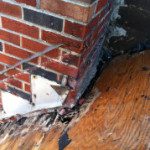
The most common and destructive type of water damage is typically rain related and includes many sources:
- Water seepage though basement walls.
- Leaks through walls at areas like doors and windows
- Roof leaks, usually through penetrations and flashing errors
- Plumbing leaks, an outlier but relevant
Bulk water leaks come in many forms from the rare catastrophic plumbing failure to the more common hidden leak that causes its damage over many years. Homeowner maintenance goes a long way to preventing and reducing problems. For those building new, we suggest hiring builders who take these matters seriously. We think blower door test results offer a fair measurement for distinguishing between builders for this type of hidden craftsmanship.
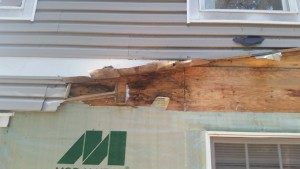
Two of the most common areas of concern I see with new construction in our area: foundation drainage and window/door flashing. Roof leaks are most structure’s biggest problem and a blog I mostly agree with is the 3 most common roof repairs. For a strict design mentality that’s sure to reduce roof leaks, check out Martin’s Ten Rules of Roof Design.
I love seeing existing homes get naked. Removing roofing and siding always reveals the surprises of hidden water damage. From brand new homes to old historical houses almost all structures are experiencing some amount of water damage somewhere.
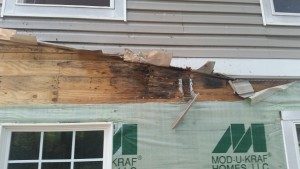
Our company is not perfect as we recently repaired leaking siding due to inadequately sloped Z-flashing, an embarassing mistake that was luckily caught early enough to avoid any apparent damage. Update: This leak reappeared and was determined to be from a failed window unit glass seal. On another house, a new roof-boot failure, #3 on most common roof repairs. It was installed appropriately (on metal roof) with no signs of holes or points of entry, yet when we removed it, there was a needle sized stain, showing where water had found a way in.
2. Air Leaks
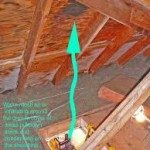
Uncontrolled, random air leaks are responsible for the second leading cause of water and moisture damage in our homes and buildings. Humid-air will deposit its moisture on cold surfaces which adds up over time to an amazing amount of moisture and resulting damage. This type of damage rarely reveals itself in the ways bulk water intrusion does but it still causes serious problems behind the finished surfaces.
- Air leaks do most of their damage in the form of energy costs. Reducing air infiltration and exfiltration is often pointed to as one of the most cost-effective strategies for reducing energy costs and resulting environmental impacts. Increasing comfort is another huge reason to pay close attention to this important issue. Air-leakage wastes money and rots homes.
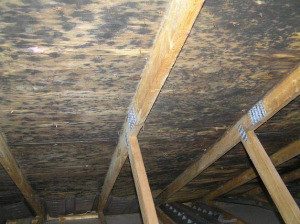
Besides increasing comfort and reducing energy costs, stopping air leaks will reduce moisture damage to building components. It’s common for inspections and remodeling to reveal mold, decay and rot at locations that have been leaking air. Sometimes air leaks contribute to bulk water leaks. Bulk water is more likely to get sucked into cracks and holes that are under negative pressure from the other side. Windy conditions pressurize and depressurize different areas of the home which increases bulk water risk in windy rain events.
A good thing about this category is you can easily measure it. The blower door test is one of the most important diagnostic tools we have in terms of home performance. Building a home tight takes more care and attention to detail. Its probably safe to say that builders that are achieving good blower door test results are implementing similar best practices to resist all forms of water damage.
 What is a Building Envelope?
What is a Building Envelope? ![]() The Blower Door Test.
The Blower Door Test.![]() Outdoor-Air Ventilation
Outdoor-Air Ventilation
3. Vapor Diffusion
Vapor diffusion is a confusing subject. There are two main ways it does damage in our climate.
- When moisture reservoir cladding (masonry, fiber cement siding, stucco) gets saturated with rain and the sun or warm outdoor temperatures drive the stored moisture towards the inside. Interior vapor barriers like vinyl wallpaper increases interior vapor drive problems. Expect more damage in our region with masonry against wood common practices.
- In the wintertime, when exterior sheathing or framing is cold and interior humidity is too high.
Amy has blogs on the subject of wintertime humidity in homes. Keep interior humidity below 40% during cold weather. Exterior insulative sheathing helps keep vulnerable structural members warmer, thus safer from risky dew points.
Its common for people to misdiagnose a vapor diffusion problem for one of the first two. When evaluating water damage, suspect number one is bulk water. Most mold inside hidden building cavities, not exposed to bulk water is caused by air leakage.
If still unsure about the differences of uncontrolled air movement and vapor diffusion, this blog may help:
Siding or exterior finish materials that store water can become a problem if not detailed correctly. Selecting the right Weather Resistive Barriers WRBs is important along with the right installation details. Rainscreens –technically required by code for brick– are an easy way to add durability and reduced maintenance to these types of exterior claddings.
Water is lazy but also persistent. It will defy gravity given the right substrates and conditions. It starts in design with features that readily shed water and are less prone to problems. Know and account for the main weaknesses during assembly on site. Prove the project is airtight with a blower door test. These are some of the most important ways of increasing the durability of homes and buildings.
Brian Knight is the owner of Springtime Builders, Asheville NC green custom home builders.



